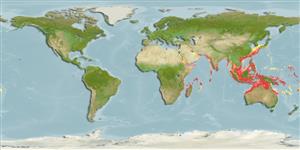>
Eupercaria/misc (Various families in series Eupercaria) >
Gerreidae (Mojarras)
Etymology: Pentaprion: Greek, pente = five + Greek, prion = saw (Ref. 45335).
Environment: milieu / climate zone / depth range / distribution range
Ecologia
marinhas; estuarina demersal; intervalo de profundidade 15 - 220 m (Ref. 12260). Tropical; 33°N - 24°S, 47°E - 158°E
Indo-West Pacific: western and southern coasts of India and off Sri Lanka to Indonesia, the Philippines and Ryukyu Islands, and south to the northern part of Australia (Ref. 3131).
Tamanho / Peso / Idade
Maturity: Lm ? range ? - ? cm
Max length : 15.0 cm TL macho/indeterminado; (Ref. 2872); common length : 10.0 cm TL macho/indeterminado; (Ref. 2872)
Espinhos dorsais (total) : 9 - 10; Raios dorsais (total) : 14 - 15; Espinhos anais: 5 - 6; Raios anais : 12 - 13. Body is slender, with weakly attached silvery scales. The spines of the dorsal and anal fins longer than the rays; the pectoral fins long and pointed, reaching beyond the anal fin spines; the anal fin is long; the caudal fin lobes rounded.
Inhabits coastal waters. Forms large schools. Probably feeds on small benthic animals. Used for fish meal and duck food.
Ciclo de vida ou comportamento de acasalamento
Maturities | Reprodução | Spawnings | Egg(s) | Fecundities | Larvas
Woodland, D.J., 1984. Gerreidae. In W. Fischer and G. Bianchi (eds.) FAO species identification sheets for fishery purposes. Western Indian Ocean fishing area 51. Vol. 2. [pag. var.]. FAO, Rome. (Ref. 3409)
Status na Lista Vermelha da UICN (Ref. 130435)
Ameaça para os humanos
Harmless
Uso pelos humanos
Pescarias: pouco comercial
Ferramentas
Relatórios especiais
Baixar XML
Fontes da internet
Estimates based on models
Preferred temperature (Ref.
123201): 21.1 - 28.3, mean 26.6 °C (based on 974 cells).
Índice de diversidade filogenética (Ref.
82804): PD
50 = 1.0000 [Uniqueness, from 0.5 = low to 2.0 = high].
Bayesian length-weight: a=0.01122 (0.00924 - 0.01363), b=3.06 (3.01 - 3.11), in cm total length, based on LWR estimates for this species (Ref.
93245).
Nível Trófico (Ref.
69278): 3.4 ±0.2 se; based on diet studies.
Generation time: 1.2 (1.0 - 1.4) years. Estimated as median ln(3)/K based on 16
growth studies.
Resiliência (Ref.
120179): Elevada, tempo mínimo de duplicação da população menor que 15 meses (K=0.70-1.80).
Fishing Vulnerability (Ref.
59153): Low to moderate vulnerability (27 of 100).
Nutrients (Ref.
124155): Calcium = 223 [91, 694] mg/100g; Iron = 0.874 [0.382, 2.690] mg/100g; Protein = 18.8 [16.5, 20.9] %; Omega3 = 0.323 [0.154, 0.725] g/100g; Selenium = 54.9 [20.4, 162.9] μg/100g; VitaminA = 11.7 [2.8, 49.6] μg/100g; Zinc = 1.11 [0.63, 2.73] mg/100g (wet weight); based on
nutrient studies.
